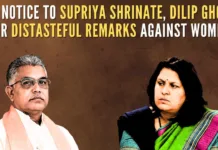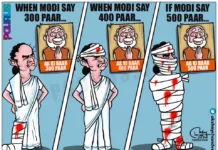
[dropcap color=”#008040″ boxed=”yes” boxed_radius=”8px” class=”” id=””]I[/dropcap]ncreasing violence in Bengal as evidenced in the current election is a mute example of a complete breakdown of law and order in this once a peaceful and the most developed state in India. The law and order scenario in Bengal has been dismal since Mamta Banerjee “Didi” took over as the ruler of Bengal. This state with a female chief minister continues to be amongst the least safe places in India for everybody but especially women. Bribery is rampant in every echelon of government; as evidenced by recent sting operations. The failure of the government in curbing this increasing tide of crime is apparent. While TMC’s claims of Mamata Banerjee’s’ personal integrity is yet to be ascertained but an “honest” queen of a band of marauders is a flawed excuse. The complete disintegration of the rule of law as evidenced in Bengal today is a phenomenon propagated by a lack of development including lack of job creation, burgeoning of have-nots and crumbling of infrastructure required to sustain a geographical area which is one of the most densely populated in the country.
Interestingly the credit of Bengal’s downslide to become poverty stricken, deindustrialized and nonperforming state goes to the three decades of communist rule under the CPM strongman Jyoti Basu. His nonperforming rule on the developmental front, especially in the last half of his stint, rendered West Bengal lose its status from its past standing and its share in all-India net value added. It may be recalled that in the initial years of independent India, West Bengal fared exceptionally well and was recognized as one of the most industrialized states in the country. In fact, until the mid-60s, Bengal was the second most industrialized state regarding value added and even surpassed the state of Bombay, (i.e. Maharashtra and Gujarat combined), as far as the number of factories and employment is concerned.
Its share of factories and jobs came down drastically, thanks to the rule of the communists. A dictatorship of the bourgeois, led by a coterie with Jyoti Basu at its helm, ensured the complete lack of industrialization, economic disintegration, and burgeoning unemployment. In the case of the manufacturing sector, the state’s share in NSDP went down from 25% in 1960-61 to 10% in 1999-2000. From 1971 to 2002, the state’s share of net value added in the factory sector fell from more than 14.38% to 4.16% and its share in employment from 16.19% to 6.99%. In 1980-81, Bengal occupied the fifth position regarding per capita income after Gujarat, Haryana, Maharashtra, and Punjab. By 2000-01, the state slipped to the tenth position. States like Tamil Nadu, Karnataka, Kerala, Andhra and Himachal Pradesh developed quickly, and West Bengal was simply not able to cope with the pace of development.
[dropcap color=”#008040″ boxed=”yes” boxed_radius=”8px” class=”” id=””]T[/dropcap]he last years of communist rule under Buddhadev Bhattacharya were ironically quite different from the iron curtain years of his predecessor. Inheriting a communist apparatchik marked by labor unrest, non-development, lack of any investment and widespread unemployment he tried to lure his comrades toward a more developmental outlook. The state government had invited Tata Motors to set up a plant at Singur, and Indonesia-based Salim Group to set up a chemical hub at Nandigram, for which, farm land was forcibly acquired using the colonial Land Acquisition Act 1894. The lumpen proletariat, who meanwhile garnered considerable power in Jyoti Basu’s style of communist dictatorship, felt un-nerved by this change and decided to change loyalties, giving rise to TMC. The massive unrest that ensued due to proletarian protests was mercilessly subdued, leading to the massacre of the general populace. The people of Bengal were less agreeable to giving Mr. Bhattacharya another chance, despite the fact that they had tolerated the non-functioning Jyoti Basu’s Stalinist regime for over 30 years.
Even after a change in government in 2011, there was no change on the industrial front. Regarding project implementation, according to the West Bengal Economic Review 2012-13, there was a fall of about 85% compared to the previous year and 97% compared to 2010, the last year of communist government. By 2013, since there was no budgetary push to boost Bengal’s industrial sector, big industries started losing faith. One of the substantial barriers to industrialization in the state has been a scarcity of land. This situation is primarily due to the Urban Land Ceiling and Regulation Act 1976, which the TMC government has refused to repeal. Even to this day, the state’s land acquisition policy continues to be a stumbling block for projects that need large tracts of land. Moreover, continuing with the communist legacy, labor unrest continued to plague the state, which recorded the highest number of lockouts. In 2014, the state’s flagship project, Haldia Petrochemicals and India’s oldest car maker, Hindustan Motors were both forced to shut down. Jute sector, the state’s second highest employment generating industry, also suffered heavy losses and about 100,000 workers lost their jobs due to labor unrest and lockouts.
[dropcap color=”#008040″ boxed=”yes” boxed_radius=”8px” class=”” id=””]T[/dropcap]he communists who dominated the Bengali social and political space for a very long time were successful in holding on to power, despite their abject lack of performance. They ensured that an army of thugs manning CPM at the ground level decided at every point where the money would be flowing and accordingly could demand cuts on every investment. It caused Bengal to alienate all investors. Even daily traders had to register their businesses to the local CPM ‘syndicates’ to ensure ‘protection’ of both their lives and property. Those few who still had the backbone to stand against this were efficaciously forced to leave the state or were maimed or exterminated into submission. Thus, the local syndicates decided whom to award contracts to build flyovers based on cutbacks paid, rather than on the most competent and experienced. The TMC was a change of regimen on paper but was structurally similar to the lumpen elements that manned CPM syndicates. These reprehensible scums soon changed colors overnight and did the same for the TMC. During the decades of communist rule, they also conveniently disseminated to every village, town and district of West Bengal and formed a network. An unholy nexus developed, symbiotically feeding the ruling apparatchik with illegally gotten wealth, and these syndicates were adequately shielded from the rule of law. Thus, though there was a change in leadership at the highest level, the apparatchik had consequentially remained the same. These criminalized syndicates were further consolidated to fund TMC coffers by induction of some former Congress leaders infamous for their thuggery. Thankful though a few of them have been jailed their control over unlawful activities in the community continues unabated. What is more shameful is the some of these incarcerated criminals continue to get TMC ticket to fight elections while being behind bars. Erosion of law and justice is perpetrated by sustaining a dysfunctional police force ensured by various means, including transferring out competent police officers who dared to offend the political rulers by doing their duty in upholding the rule of law.
The people of Bengal deserve a respite from years of turmoil and lack of opportunities for development as ensured by the Communists & their replacement the TMC. With Bengals recently concluded elections change can is anticipated if free and fair elections were held. Since the communist takeover of Bengal, the concept of the free and impartial election, despite the best efforts of the Election Commission seems to be a fantasy ride. Party men are plugged in at every possible level starting from police to government employees to volunteers manning election booths to ensure that ruling candidates are ‘reelected’ to power. Moreover, an unprecedented quantum of violence was unleashed in the recent election to ensure a minimal turnout of voters.
While awaiting election results, one alternative may be that both the communist party and TMC get a similar number of seats. In that case, at least theoretically, they could bring in an aggressive agenda of development to a state weary of years of anarchy and bankruptcy. That is only if only they are willing to mend their ways under checks by political opponents if there is a close election result. This election has BJP as a new player in the theater of Bengal politics. The party is yet to show that it cares for Bengal by promoting intellectuals and filling its ranks with thoroughbreds rather than weathered lumpen elements from erstwhile CPI-M/TMC. These are infamously called “Tarmuj” or watermelons in Bengali-green outside (TMC color) and red inside (CPM), who have no qualms in facilely changing to BJP’s orange.
It has been gratifying, as an Indian staying abroad, to see that some elements in the political fraternity have finally succeeded in bringing development to the forefront as the prime mantra for political survival in India. It is sad that while in many parts of India the electorate has blossomed to utilize this mantra to decide their political rulers, the state of Bengal continues to lag behind.
About the author: Indranill Basu Ray, The author, is the Chairman of the nonprofit Indo-American Developmental Council based in Houston, TX, USA. Research inputs by Anirudh Rakshit, Kolkata, India.
- ModiCare – not enough to modify years of neglect! - April 23, 2018
- Gorakhpur Death-A Clarion Call to Change the Rotting Health System - September 22, 2017
- Paradise lost to violent radicals – Basirhat: a case in point - July 11, 2017










